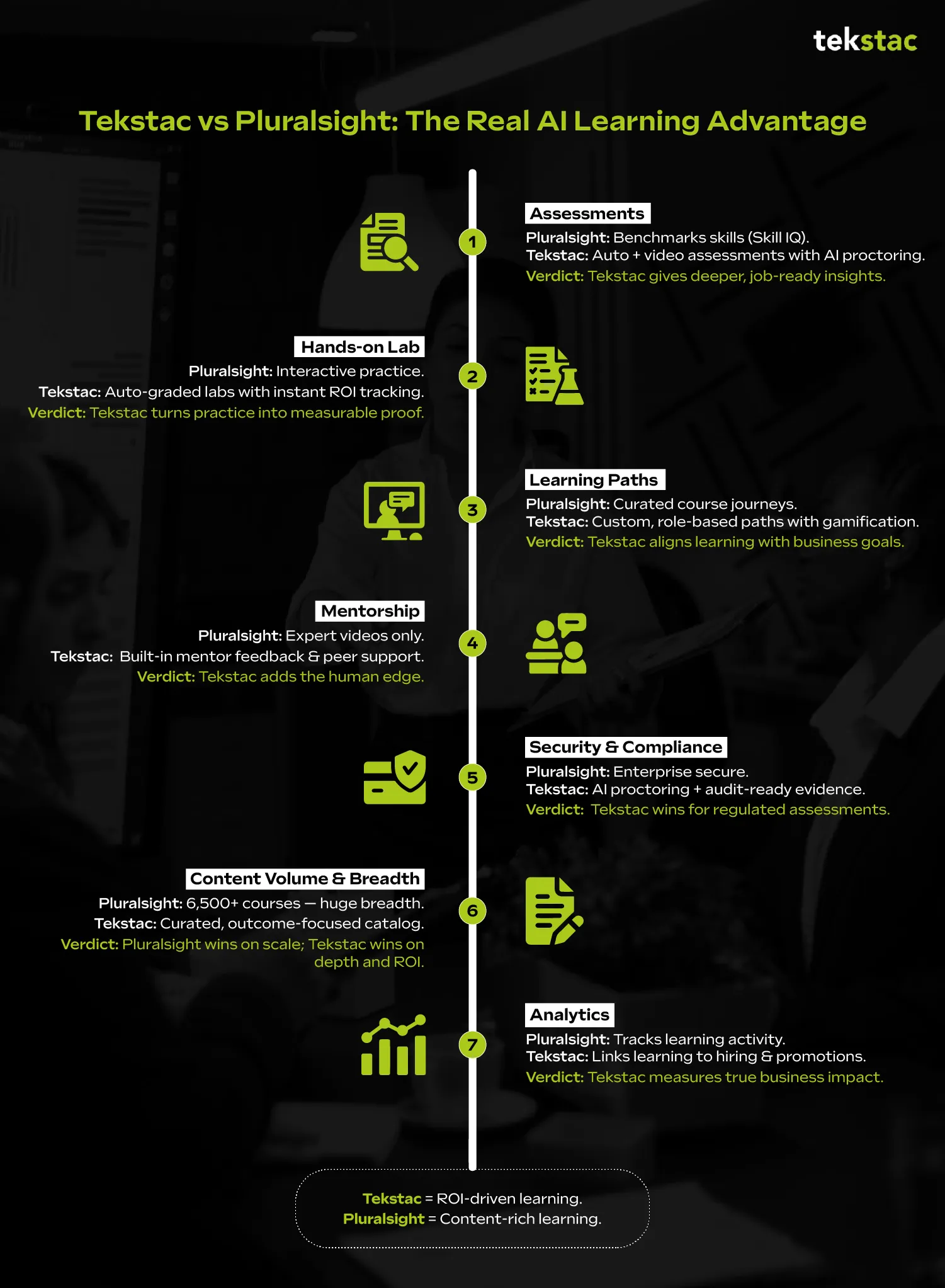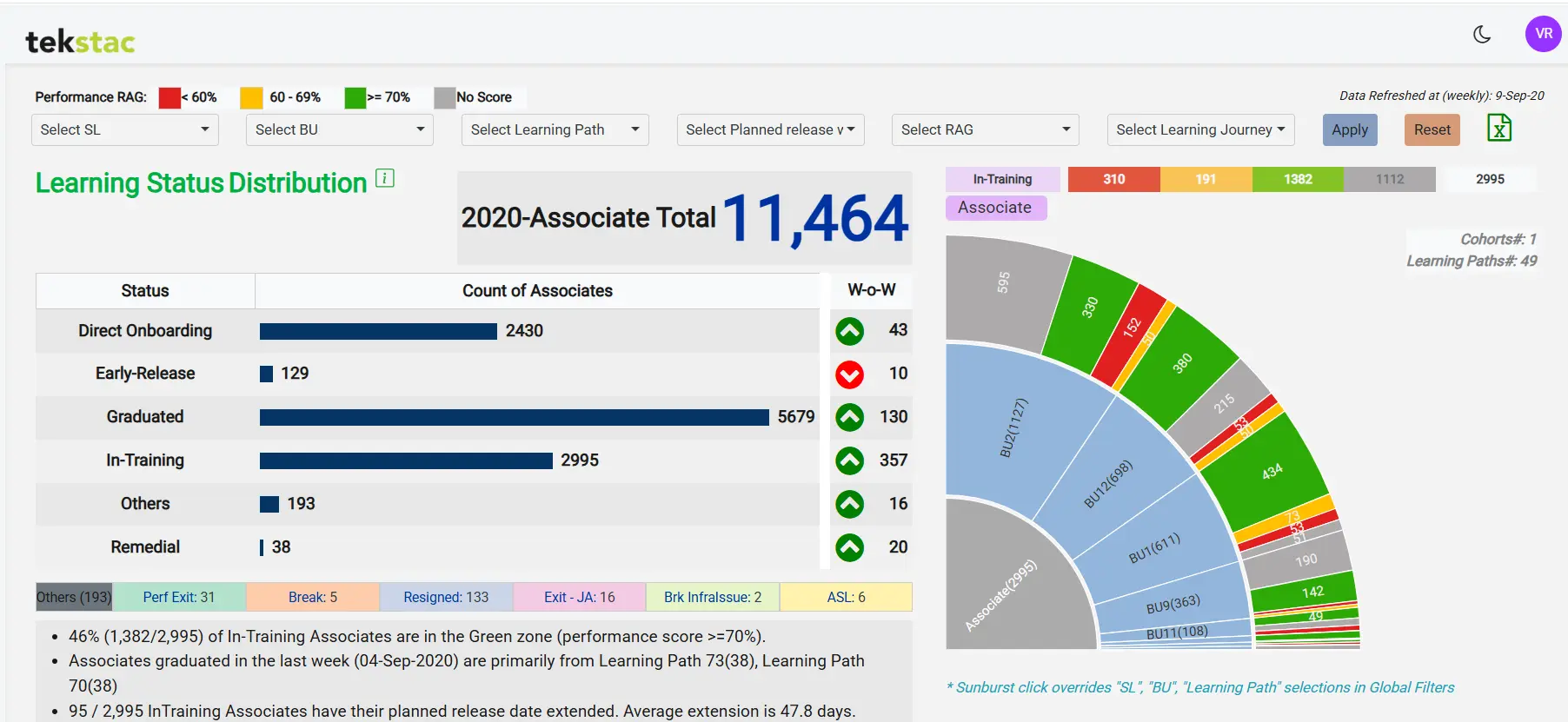Tekstac vs Pluralsight: In-depth Feature and ROI Comparison

Imagine this: You’re leading L&D and need to decide how to spend your training budget. But you’re not sure how to measure if the programs are working. Sounds tricky, right? Actually, it’s not as hard as it seems. That’s where ROI comes in.
Every L&D leader today is looking at the cost v/s benefit of learning platforms to create a sustainable plan for the upcoming years.
Hence, choosing the right skilling platform that aligns with your goals becomes paramount. Here is a detailed ROI comparison between the two top-rated skilling platforms Tekstac and Pluralsight, to help you choose the right one.
ROI Comparison overview: Tekstac vs Pluralsight
When comparing Tekstac vs. Pluralsight, it’s crucial to understand their differences in content, certification, pricing, and learner focus. Both platforms cater to learners, but they differ in measuring corporate training ROI metrics.
Tekstac is an enterprise tech skilling platform with learning content, hands-on practice labs, assessments, ROI measurement dashboards and skills inventory tracking.
In contrast, Pluralsight specializes in 6,500+ tech-focused courses, tailored for IT professionals, developers, and engineers.
Who is Tekstac best for?
Tekstac is best suited for enterprises and learning leaders who need a 360-degree skilling platform to enable large-scale talent transformation. It is designed for organizations that want to upskill employees, accelerate role readiness, and track ROI on learning investments.
Who is Pluralsight best for?
Plural-sight is best for programmers, data scientists, data analysts, software engineers, computer engineers, IT professionals, and anyone in the tech workforce.
Here is the concise comparison table:
| Tekstac Features | Pluralsight Features |
|---|---|
The all-in-one platform features:
|
Prominent features include:
|
Tekstac vs Pluralsight: Which Platform Delivers Better ROI?

1. Assessments (What they measure and how they scale)
Pluralsight offers structured skill assessments (Skill IQ/Role IQ) to benchmark knowledge and recommend learning paths; these are useful for quickly measuring where a learner stands and for driving recommended content.
Tekstac, however, approaches assessment as a two-layered capability: instant, auto-evaluated assessments that gamify learning and deliver granular analytics, plus video assessments that evaluate communication, problem-framing, and applied thinking.
For companies doing a training ROI analysis, Tekstac provides a clearer picture of learner readiness and impact.
Verdict: Pluralsight’s Skill IQ provides a good benchmark, but Tekstac’s mix of auto-evaluated scoring, video responses, AI proctoring and mentor rubrics gives a richer, hire-ready assessment signal.
2. Hands-on labs and practice environments
Pluralsight has invested heavily in hands-on experiences: interactive labs, sandboxes, and in-browser code labs that let learners practice with cloud and desktop environments. These labs are great for isolated practice and platform familiarity.
Tekstac’s Auto-Evaluated Labs take it a step further, offering instant grading, personalized feedback, and corporate training ROI metrics by tracking skills acquisition in real time. Every submission is auto graded against test cases and performance metrics, with step-by-step personalized feedback and cohort analytics.
Tekstac’s labs are positioned as part of a continuous learning lifecycle, which reduces manual grading load and makes lab results usable as hiring or promotion evidence
Verdict: Pluralsight’s labs are excellent for practice; Tekstac’s auto-evaluation and integrated analytics convert practice into defensible proof of ability that clearly influences L&D ROI comparison.
3. Learning paths and personalization
Pluralsight’s core strength is a mature, searchable catalog and curated learning paths that guide learners from fundamentals to advanced topics, and the platform surfaces tailored recommendations based on assessment results.
Tekstac takes a different tack: instead of only offering pre-built paths, Tekstac promises 100% customizable, role-aligned learning journeys, LTI integration so existing third-party content can be unified, and gamified milestones to drive engagement. This ensures learning outcomes are directly tied to training ROI analysis.
Verdict: The combination of role mapping, gamification, and live dashboards means Tekstac’s paths can be tuned to business outcomes rather than just course completion.
4. Mentorship, human feedback and peer support
Pluralsight primarily scales through expert-authored video content and automated assessments; while it does offer guided learning experiences, direct mentoring/rubric-driven mentor review is not a core platform differentiator in the same way Tekstac makes mentoring part of the learning flow.
Tekstac’s Mentor Connect couples one-on-one and group mentoring, structured rubric feedback, and peer forums so learners get timely human guidance tied directly to assessment outputs. That human loop is especially valuable for borderline cases, candidate interviews, or nuanced technical topics where automated feedback can’t capture judgment or communication.
Verdict: Mentorship is blended into Tekstac’s product design, contributing to a higher Tekstac ROI, whereas Pluralsight focuses more on self-paced content and automated benchmarking.
5. Security, proctoring and enterprise compliance
Pluralsight markets enterprise features and governance for teams, and it’s widely used across companies for secure upskilling. But when it comes to integrated, assessment-level proctoring, that is not the headline differentiator Pluralsight promotes.
Tekstac’s Secure Proctoring Hub is designed natively into the assessment flow: AI monitors for impersonation, tab switching, unusual audio, produces confidence scores, and generates concise evidence packages for mentor review.
For regulated assessments, hiring decisions, or certification-grade testing, Tekstac’s approach reduces risk and administrative overhead while preserving learner experience. This level of compliance demonstrates the cost vs benefit of learning platforms in highly regulated environments.
Verdict: For high-stakes assessments and auditability, Tekstac’s native AI proctoring and reporting are stronger.
6. Content volume and course breadth
Here Pluralsight’s strength is indisputable: the platform advertises access to 6,500+ courses and thousands of hands-on labs and sandboxes, covering an exceptionally wide range of tech domains and vendors. For individual learners or teams who need breadth, Pluralsight’s catalogue is a compelling advantage.
Tekstac intentionally focuses on curated learning paths, role-aligned journeys and integrated assessment rather than quantity of discrete courses. If your priority is access to the largest possible library and immediate on-demand topic variety, Pluralsight gives more in volume
Verdict: Pluralsight has the upper hand here, when sheer scale and variety of course content are the deciding factor.
7. Analytics and business impact measurement
Pluralsight provides analytics and enterprise reporting (usage, skill gaps, role IQs) that help teams measure progress, but those analytics are principally consumption and assessment-level signals.
Tekstac layers skill-inventory analytics, cohort trend analysis, growth path analyzers, and ties assessment outputs (auto-graded labs + video rubrics + proctoring signals) to role readiness and hiring/upskilling decisions. The result is a product that not only shows who watched what, but shows who is demonstrably ready for a particular role or responsibility — and why.

Verdict: Tekstac’s analytics are explicitly designed to drive HR and L&D decisions (hiring, promotions, targeted reskilling), not just measure activity.
Why do companies check Tekstac vs Pluralsight ROI comparison chart?
ROI measurement is not a cakewalk in L&D. You need to answer a lot of questions. How do enhanced skills impact the organization’s financial strength? How does the company scale with other competitors in L&D ROI comparison? And so on.
Tekstac v/s Pluralsight ROI comparison will give insights on how they compare to one another in one of the most crucial metrics.
Pluralsight ROI metrics
Pluralsight training ROI analysis suggests that a 295% return on investment (ROI) over three years, with organizations seeing full payback in under six months, according to a Forrester Total Economic Impact™ study.
The ROI is driven by faster onboarding, improved employee retention, and accelerated product development, resulting in millions in productivity gains.
Tekstac ROI metrics
Unlike Pluralsight’s ROI comparison, Tekstac measures learning impact through skills outcomes, productivity, retention, and alignment with business goals.
Tekstac supported 110,000+ learners for one of its leading tech clients, improving talent identification, reducing hiring and training costs, accelerating productivity, boosting engagement, optimizing program management, and improving ROI.
Tekstac builds evolving, real-time skill profiles (“SkillTag”) per learner, integrating assessments and workplace data to inform talent strategies.
Final Thoughts: ROI Comparison and Key Takeaways
Both Pluralsight and Tekstac are top upskilling platforms—Pluralsight with expert-led learning, and Tekstac with real-world coding practice.
So, what’s right for you?
Pluralsight remains an industry leader for individuals and teams looking for an expansive, expertly authored course library with hands-on practice options. If your top priority is content breadth and immediate access to thousands of tech topics, Pluralsight is the safer pick.
But for organizations that is looking not just content but a comprehensive skill development platform that includes assessments to mean something (beyond “course complete”), want labs that act as verifiable proof of capability, require low-friction, enterprise-grade proctoring, and value human mentoring tied directly to analytics and role outcomes, Tekstac is the more outcome-oriented platform. Most importantly, Tekstac empowers the organization’s L&D teams with proven ROI that is clear and actionable.
Frequently Asked Questions on ROI Comparison
1. What is ROI in L&D?
ROI in Learning & Development is a way to measure how much value your organization gets from investing in employee training and development.
2. What factors influence L&D ROI comparison in companies?
Several factors impact L&D ROI comparison, including relevance of learning content, engagement levels, skill application on the job, and alignment with career progression or internal mobility goals. Platforms that integrate assessments, mentorship, and analytics, like Tekstac, provide richer insights for comparing ROI and making informed talent decisions, including promotions and lateral hiring.
3. How can organizations measure training ROI effectively?
Training ROI can be measured by tracking improvements in employee performance, time-to-competency, internal mobility readiness, and impact on business outcomes.





